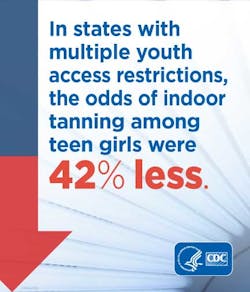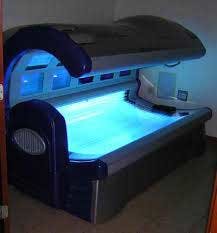Protecting our children
The numbers of states implementing new laws regarding indoor tanning have increased substantially in recent years. At this time, six states (California, Illinois, Nevada, Oregon, Texas, and Vermont), restrict indoor tanning among minors aged younger than 18 years.(7)
The World Health Organization (WHO) recommends that no one under the age of 18 years use indoor tanning. The FDA has proposed reclassifying indoor tanning devices from low- to moderate-risk devices. The proposed order advises against the use of indoor tanning among minors aged younger than 18 years.
For information about CDC’s efforts in skin cancer prevention, visit the website.(8)
References
1. Branum AM, Rossen LM and Schoendorf KC. Trends in Caffeine Intake Among US Children and Adolescents. Pediatrics 2014;133:386–393. http://pediatrics.aappublications.org/content/early/2014/02/04/peds.2013-2877.full.pdf.
2. FDA. Medicines in my Home: Caffeine and Your Body. http://www.fda.gov/downloads/drugs/resourcesforyou/consumers/buyingusingmedicinesafely/understandingover-the-countermedicines/ucm205286.pdf.
3. http://www.fda.gov/forconsumers/consumerupdates/ucm350570.htm.
4. http://www.cnn.com/2013/05/08/health/wrigley-caffeine-gum-production/.
5. Mark A. Seeley, Joel J. Gagnier, Ramesh C. Srinivasan, Robert N. Hensinger, Kelly L. VanderHave, Frances A. Farley, Michelle S. Caird. Obesity and Its Effects on Pediatric Supracondylar Humeral Fractures. The Journal of Bone and Joint Surgery(American), 2014; 96 (3): e18 DOI: 10.2106/JBJS.L.01643.
6. Gery P. Guy Jr, Zahava Berkowitz, Sherry Everett Jones, Emily O’Malley Olsen, Justin N. Miyamoto, Shannon L. Michael, and Mona Saraiya. (2014). State Indoor Tanning Laws and Adolescent Indoor Tanning. American Journal of Public Health. e-View Ahead of Print. doi: 10.2105/AJPH.2013.301850.
7. http://www.cdc.gov/media/releases/2014/p0213-indoor-tanning.html.
8. http://www.cdc.gov/cancer/skin.




